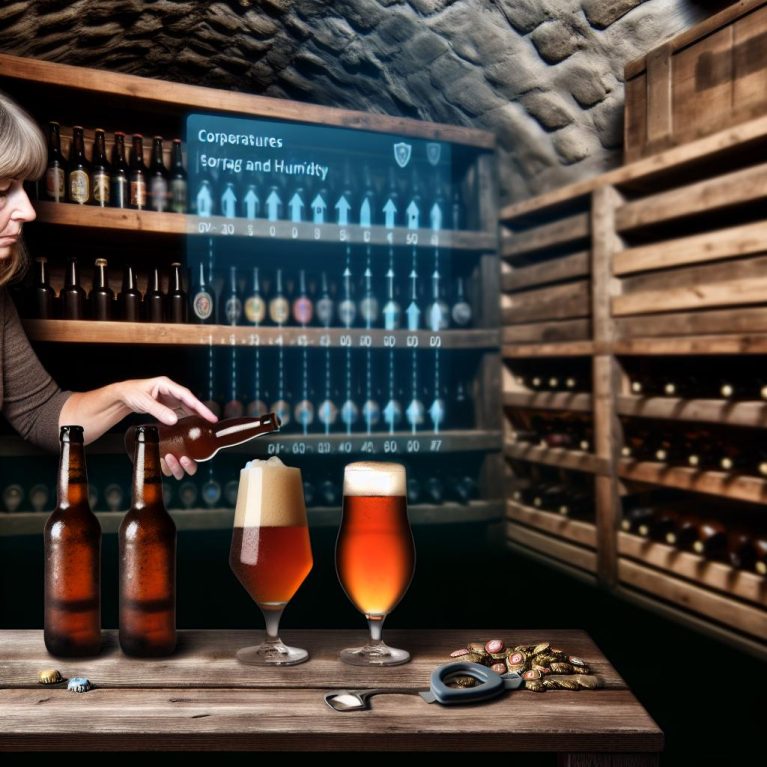Introduction
Craft beer, with its unique flavors and intricate characteristics, presents a fine balance of art and science. For enthusiasts who have developed a palate for these specialty brews, understanding the intricacies of storage and serving is critical. These considerations are not merely about maintaining the beverage’s palatable quality; they enhance the entire experience from the moment the bottle is opened until the last sip is savored. The subsequent information is a guide to ensuring that each glass of craft beer provides a taste adventure that is as close as possible to the brewer’s original intention.
Proper Storage of Craft Beer
The importance of proper storage techniques for craft beer cannot be overstated. Since beer is sensitive to environmental factors, achieving the perfect balance in storage conditions can make a significant difference in taste and aroma.
Temperature
Craft beer enthusiasts should prioritize maintaining an optimal storage temperature between 45-55°F (7-13°C). Variations beyond this range can detrimentally impact the beer’s chemical equilibrium. When stored too warm, the beer can undergo premature aging, developing flavors that may overwhelm the intended taste profile. On the other hand, excessively cold storage can suppress the richness of flavors and aromas, muting the beer’s natural vibrancy. Therefore, maintaining a consistent temperature is essential—temperature fluctuations can disrupt the beer’s stability, leading to potential degradation of quality.
Light Exposure
The nuances of craft beer can be easily damaged by exposure to light, especially sunlight and sources of ultraviolet (UV) rays. Such exposure can lead to a condition colloquially known as being “lightstruck,” which imparts a noticeably unpleasant skunky aroma to the beer. It is essential to store beer in dark, cool places designed specifically to block out harmful light. For those without traditional cellar spaces, a refrigerator with opaque doors serves as an adequate substitute. Furthermore, it is advisable to keep the beer in its original packaging or other opaque containers designed specifically to offer protection against light exposure.
Storage Position
Unlike wine, where horizontal storage is traditional and beneficial, beer, including craft varieties, generally favors an upright storage position. Storing craft beer vertically minimizes the beer’s contact with the cap, significantly reducing the risk of oxidation and contamination from cap linings—a primary concern with craft beers that are often more sensitive to such exposure. Vertical storage also preserves the beer’s stability over time, maintaining its intended taste profile.
Serving Craft Beer
Correctly serving craft beer is as crucial as storing it properly. The serving process greatly influences the beer’s flavor, aroma, and overall drinking experience.
Temperature
Serving temperature is a significant contributing factor to the enjoyment of craft beer, as temperature variations alter the perception of flavors. Lighter beers traditionally benefit from a colder serving condition that complements their crisp, refreshing taste. Conversely, darker or stronger beers may come alive at slightly warmer temperatures, which help to release their complex aromatic compounds. Consider the following guidelines:
– Light Lagers: Serve at 38-45°F (3-7°C) to achieve a clean, chilled taste that enhances the beer’s refreshing attributes.
– Pale Ales and IPAs: A moderate serving range of 45-50°F (7-10°C) is ideal to balance the hoppy flavors and aromatic delicacy.
– Porters and Stouts: These fuller-bodied beers benefit from a serving temperature of 50-55°F (10-13°C) to fully express their rich, deep tones.
These ranges ensure that the beer’s intended characteristics can truly shine through without being masked by excessive chill.
Glassware
The choice of glassware plays a pivotal role in enhancing the craft beer experience. Various beer styles are best appreciated when paired with suitable glass shapes, designed to accentuate their respective qualities. For instance:
– Pints: This versatile glass is most suitable for sessionable beers like pale ales and stouts, providing simplicity and balance.
– Snifters: Best for more potent ales and barleywines, snifters concentrate aromas, allowing the drinker to fully appreciate their layered complexity.
– Weizen glasses: Specifically for wheat beers; these glasses help capture and sustain voluminous, fluffy heads typical of such beers.
Employing the correct glassware not only supports proper head retention and aroma enjoyment but also complements the beer’s aesthetic appeal.
Pouring
The manner of pouring is integral to the craft beer drinking experience. A correctly poured beer not only looks appealing but also optimizes the aroma release, which is critical for appreciation of craft beer’s intricate flavors. The recommended technique involves tilting the glass at a 45-degree angle and gently pouring the beer down its side. As the glass nears half-full, it should be straightened, permitting the beer to cascade more directly into the center. This technique aims to culminate in a head that is about 1-1.5 inches thick, establishing an aromatic foam that enhances the overall sensory experience.
Conclusion
Adherence to these practical guidelines for the storage and service of craft beer allows enthusiasts to deliver the fullest expression of the beer’s flavors and aromas directly to their palate. While personal preferences may influence certain aspects of the experience, these foundational practices provide an excellent baseline for honoring the intricate complexity of craft brewing. For those eager to delve deeper into the world of craft beer, resources such as Brewer’s Association websites, alongside craft beer-specific forums and communities, offer a wealth of information and shared expertise. Engaging with these resources not only broadens one’s understanding but also strengthens the global community of craft beer aficionados.

